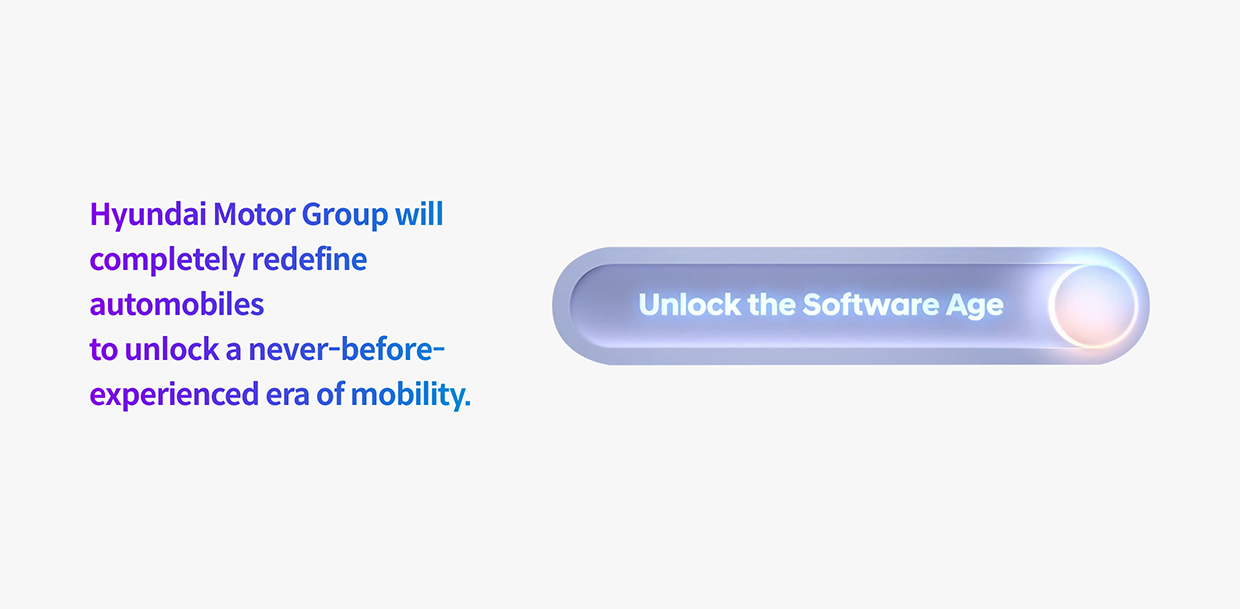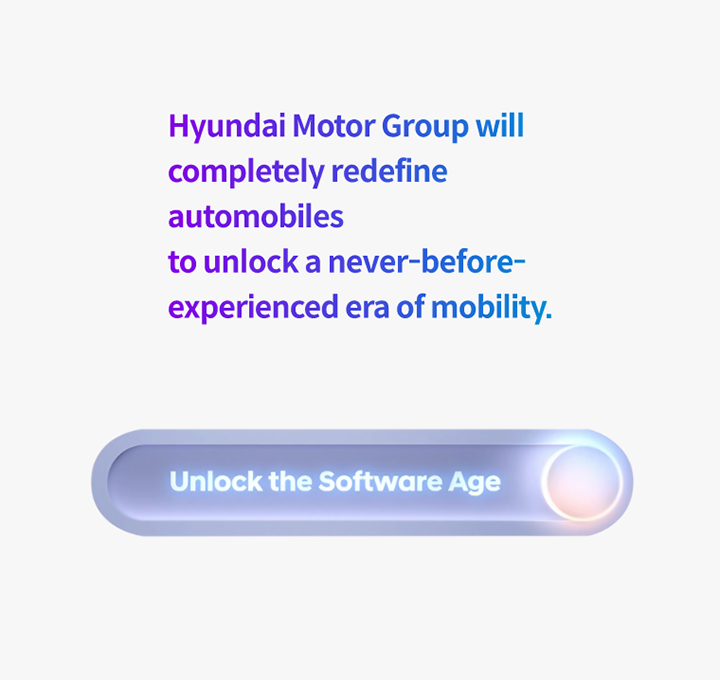Unlock
Software technology lies at the center of surpassing physical limits through new technology and creating more seamless mobility experiences for our customers.
Hyundai Motor Group is redefining the concept of automobiles
with advanced software technology.
Hyundai Motor Group will redefine the paradigm of the mobility industry through Software Defined Vehicle that always provide improved performance and new features, just like a smartphone.
Software technology lies at the center of surpassing physical limits through new technology and creating more seamless mobility experiences for our customers.
Hyundai Motor Group is redefining the concept of automobiles with advanced software technology.
Hyundai Motor Group will redefine the paradigm of the mobility industry through Software Defined Vehicle that always provide improved performance and new features, just like a smartphone.
View all events
Watch the full version of the event video on the screen below.
Watch the full version of the event video
on the screen below.
Download Press Kit
Hyundai Motor Group will
completely redefine
automobiles
to unlock a never-before-
experienced era of mobility.


This change has already begun. You can see the SDV technology being developed by Hyundai Motor Group and the vision of the future mobility industry in our Software House.
The Software House has five floors.
These floors feature the Vehicle Platform, Electrical/Electronics Architecture,
Software Platform, Data Platform,
and the stories about the new challenges of Hyundai Motor Group.
We invite you to Hyundai Motor Group’s
‘Software House’.
This change has already begun.
You can see the SDV technology being developed by Hyundai Motor Group and the vision of the future mobility industry
in our Software House.
The Software House has five floors.
These floors feature the Vehicle Platform, Electrical/Electronics Architecture, Software Platform, Data Platform,
and the stories about the new challenges of Hyundai Motor Group.
We invite you to
Hyundai Motor Group’s
‘Software House’.
Vehicle Platform
Conversion of next-generation EV platforms and ICE vehicles into SDV
Conversion of next-generation EV platforms and
ICE vehicles into SDV
A Software Defined Vehicle (SDV) is one that consistently evolves around the software. The software enables control and management of the vehicle functions. With this, continuous updates will also be made on vehicle driving performance, convenience features, safety specifications, and emotional quality.
Hyundai Motor Group aims to develop all of its electric vehicles sold worldwide and ICE vehicles into software defined vehicles by 2025.
For this, Hyundai Motor Group is concentrating on developing a EV-dedicated platform, which is the cornerstone of SDV.
In 2025, Hyundai Motor Group will present vehicles with two platform types: “eM,” a passenger EV-dedicated platform and “eS,” a dedicated platform for Purpose Built Vehicles (PBV).
These new platforms are evolving under “Integrated Modular Architecture (IMA)”, which integrates hardware and software. The IMA keeps our exclusive platform’s unique advantages, while maximizing EV product competitiveness. It even has the flexibility to apply to various other segments.
Most importantly, you can convert any electric vehicle into an advanced SDV with increased technical reliability.
From 2023, all newly launched vehicles will be equipped to receive Over-The-Air (OTA) software updates enabling customers to keep their vehicles up to date.
Electrical/Electronic Architecture
Domain centralized architecture
With a growing number of convenience features provided by vehicles, the number of electrical components used in vehicles has increased significantly. Hyundai Motor Group has designed the vehicle’s Electrical/Electronic architecture to be “domain centralized” to manage the increasing number of electrical components with systematic efficiency.
The Electrical/Electronic architecture can be viewed as a structural diagram that is organically connected to each other so that car's electrical device components can function properly.
The domain-centralized architecture divides the major functions of a vehicle into 4 areas: Comfort, Driving, Infotainment, and ADAS to ensure vehicles improve efficiently through OTA updates.
And integrating control functions of these four areas into each top-level controller makes our development process more flexible, as we add new functions or improve performance.
In addition, we are set to dramatically reduce the overall number of controllers by integrating the lower-level electrical components managed by top-level controllers.
Hyundai Motor Group will apply domain centralized architecture globally to all car types by 2025, to develop smart mobility that is safer and faster to update.
Software Platform
Hyundai Motor Group’s own vehicle operating system, “ccOS”
Hyundai Motor Group’s
own vehicle operating system, “ccOS”
To implement advanced software technology in a vehicle, an operating system is essential. Hyundai Motor Group developed its own exclusive vehicle operating system, the Connected Car Operating System (ccOS), to control vast amounts of vehicle data and a number of electrical components efficiently.
ccOS is an independent software platform designed to quickly process the vast amount of data used in connected cars and provide stable services.
Cars running on ccOS can perform computations at blazing speeds, while simultaneously processing data, all with total stability. In addition, ccOS uses a standardized architecture, that can be shared with every controller. That means easy maintenance, quick response to fast-changing market demands, and high-performance computing power to take hardware performance to the max.
Based on ccOS optimized for software-defined vehicles, Hyundai Motor Group will provide quick and seamless updates and a variety of in-vehicle content for new mobility experiences.
Software Platform
ccOS.a for the advancement of autonomous
driving technology
ccOS.a for the advancement of
autonomous driving technology
With Hyundai Motor Group’s ccOS, we can also expect a big leap in autonomous driving technology. Hyundai Motor Group has developed ccOS.a with fast network speeds and data processing capabilities to implement advanced autonomous driving technology.
Additionally, we are mass-producing a new autonomous driving architecture based on 2nd generation integrated controllers that has standardized specifications and added a network dedicated to autonomous driving since late 2019. Through this, Hyundai Motor Group is developing level 3 Highway Driving Pilot (HDP) and Remote Parking Pilot (RPP) in accordance with domestic and international regulations. We will continue to enhance primary functions through OTA software updates.
On top of this, the 3rd generation of integrated controllers is already being developed, based on next-generation high-performance processors. Through this, we will lay the foundation for timely mass production of level 4 and 5 autonomous vehicles.
Data Platform
Collection and analysis of vehicle lifecycle data
Hyundai Motor Group is building a data platform that collects, processes, and analyzes not only vehicle driving information but also all information generated in the entire lifecycle of the automobile.
Data platform refers to a system that collects, processes, and analyzes vast amounts of data generated from vehicle design, manufacturing, sales, driving, and used car sales activities.
Data selectively collected and processed through the data platform plays an important role in enhancing the convenience and diversity of the customer’s mobility experience
For example, data like traffic signals, surrounding objects, geographic information such as maps, and other various data generated by a vehicle while driving can also play a very important role in advancing autonomous driving technology.
Going forward, the data platform will help create a new mobility ecosystem, connecting cars with other mobility devices, based on data connectivity and scalability.
The new challenges of Hyundai Motor Group
The new challenges of
Hyundai Motor Group
Establishing a Global Software Center
The automotive industry is transitioning from hardware-defined to smart software-defined vehicles. With SDVs, a big change is expected in the mobility of customers.
Hyundai Motor Group is embarking on a new challenge accordingly. Even if you don’t own a car, you’ll be able to experience convenient, uninterrupted travel as though you do.
With one account, it will be possible to connect and use various mobility devices under development, including Advanced Air Mobility (AAM), PBV, robots, and robotaxis.
And software will be the core technology that delivers this future by seamlessly connecting new mobility devices and services.
Hyundai Motor Group will establish a Global Software Center to preemptively respond to changes in the future mobility market. The Global Software Center will develop software-defined mobility devices and services to enter new markets. Next, we’ll construct a system for self-developed mobility devices to connect to smartphone ecosystems.
We hope you’ll stay informed as Hyundai Motor Group takes on the challenge of creating a new dimension of the future mobility ecosystem.